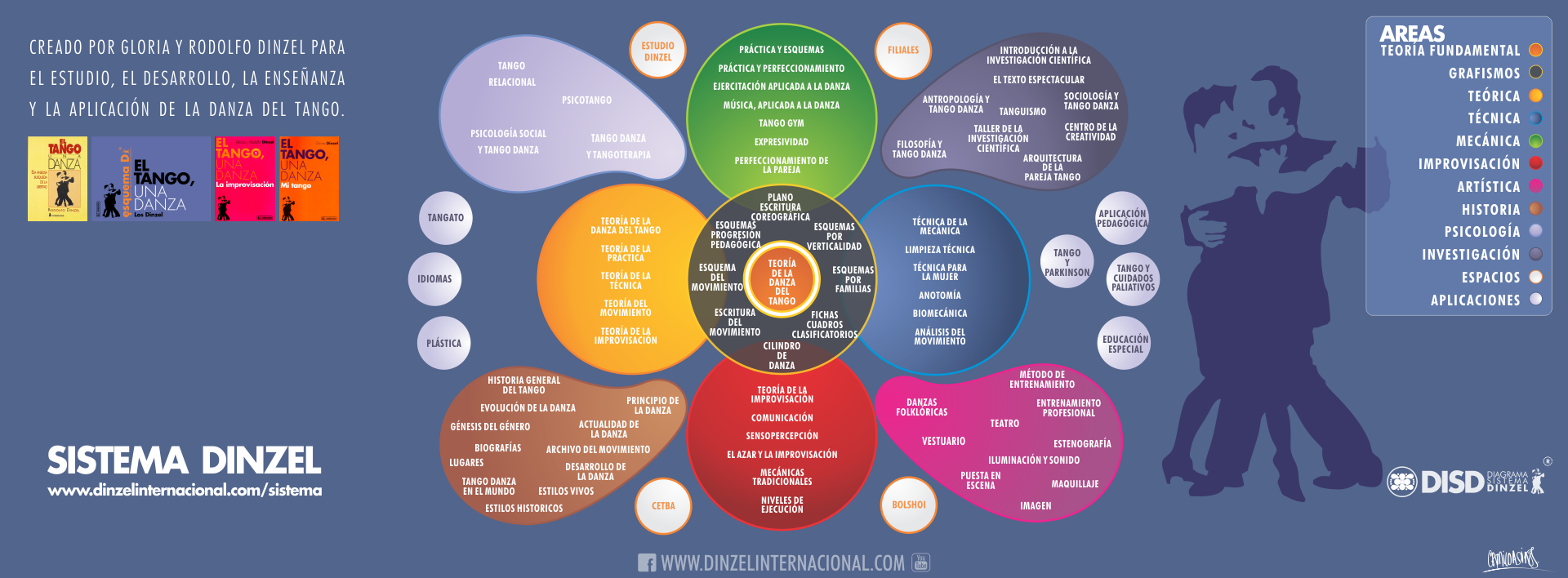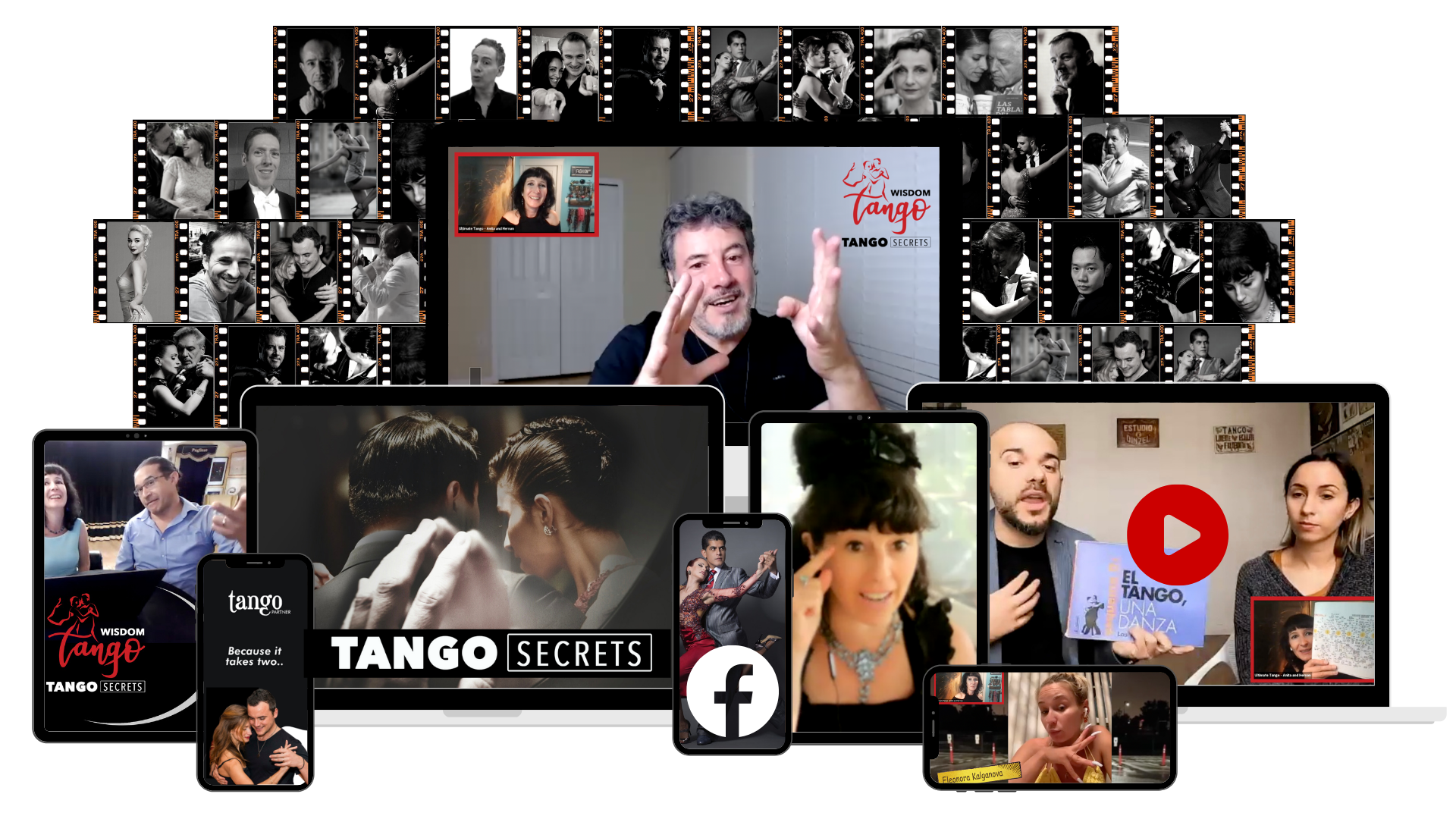Los Dinzel and the Dinzel System
The principles of Argentine tango hinge primarily upon such broad concepts as improvisation, freedom, energy, and passion.
However, there are noteworthy personalities in this world of dance who have endeavored to find structure amid what initially appears to be a dance completely based on emotions. This is clearly seen in the achievements of Gustavo Naveira and Giselle Anne, maestros of the craft who, together with their contemporaries, came up with the Tango Nuevo movement.
Photo by borichenko@yahoo.fr
Of course, many others have contributed greatly to a more profound and technical understanding and appreciation of Argentine tango. Among these are the inimitable Gloria Dinzel and Rodolfo Dinzel, more popularly referred to as Los Dinzel throughout their long and unparalleled career as tango dancers. In fact, Naveira himself credits the Dinzels as his first teachers.
Los Dinzel have gone on to teach innumerable students their remarkable Dinzel System, enriching the lives of tango dancers all over the world under their tutelage, many of whom, like Naveira, have become maestros of the craft in their own right.
Los Dinzel: Early Beginnings
Before they decided to call themselves Los Dinzel, the one name that, as described by the introductory address in the National Tango Academy's inauguration lecture on September 4, 2014 “defines them and defines how to interpret tango,” there was Gloria Ines Varo and Carlos Rodolfo Dinzelbacher. As individuals, both Gloria and Rodolfo began their journey into dance at a very young age, often crediting family as their very first influences on tango and dancing in general.
In a 2014 interview with Pepe Palazon, Gloria Dinzel recalls how she became acquainted with tango through family: “Me, I knew tango since I can remember because my parents danced to tango. All my family, from the Italian side, they all met at the social club, the Sporting — it's still open today. So I listened to it since I can remember. My grandma used to babysit for us and we used to play with our cousins...
“And that was tango. Back then, tango was a family thing.”
Gloria began dancing classical ballet at the age of 8 and graduated from the Instituto Superior de Arte del Teatro Colón de Buenos Aires in 1967. She then decided to focus solely on tango at the age of 19, when she traveled to Europe and became the first dancer of tango choreographer and dancer Angel Eleta.
It was something for the family. [...] I love watching my parents dance to tango, and since they always fought, to see them embrace and my mother close her eyes and fly away with the music... I loved that! I couldn't stop watching!”
Rodolfo Dinzel, on the other hand, recounts in an interview with Gabriel Soria in Historia de Oro that it was his father who piqued his interest in dancing and encouraged him and his brothers to have formal education early on. At the age of 4, Rodolfo was a listener in the National School of Folkloric Dances. Two years later, he participated in a children’s contest of the same institution. At 14, he began his professional career as a folkloric dancer but, by the age of 16, he had decided to dedicate himself entirely to tango, forsaking folkloric dances altogether just as he graduated from the Escuela Normal Mariano Acosta in Buenos Aires.
Together as Los Dinzel, Gloria and Rodolfo traveled all over the world as part of the company Tango Argentino, performing as dancers and choreographers.
According to SoTango, Los Dinzel “became famous after they joined the cast of the show Tango Argentino, which premiered on Broadway in 1985. The show toured internationally and ran for more than a decade.
The production became a huge success worldwide, and was a major influence on the global renaissance of tango as a dance and musical genre…
[Aside from] their stage performances, Los Dinzel are revered for their teaching and research into Argentine tango. As a result of over 40 years of research, they developed a teaching methodology for tango that they call ‘The Dinzel System.’”
Los Dinzel and the Dinzel System
As an iconic tango couple who soon became known worldwide, Los Dinzel and their Dinzel System reached various parts of the world, influencing many tango maestros who were taught under this specific system.
As a result, one may encounter various interpretations of the Dinzel System, though they all highlight it as a teaching methodology.
The Catedral Estudio de Tango describes the Dinzel System as follows:
“The Dinzel system is the result of many years of observation, research and knowledge transfer of Tango dancing, developed by Rodolfo and Gloria Dinzel.
It is a collection of the key elements that define the aesthetics of Tango Argentino. The result is a detailed technique that allows each student to build their own dynamics and their own individuality within a group.
The Dinzel system distinguishes improvisation as the dominant stone to the edifice called Tango, which allows anyone to dance freely but with respect to each other, sharing the same space and time.”
Worry not! We asked Eric Dinzel - the son of Los Dinzel - what all this means! Coming soon!!!! - Tango Secrets Summit - Register now!
On the other hand, Amparo Ferrari, also a tango teacher who studied under the Dinzel System, describes it as a “result of more than 40 years of passion for dance, research and work;
it is a compilation of philosophical and scientific ideas, rules, procedures, forms, methods, techniques and mechanics. These form a coherent unit, designed for Tango creative development, study, research, and teaching.
The system is used at Estudio Dinzel in Buenos Aires, at the ‘Tango Educational Center,’ the former University of Tango, as well as by teachers in several countries. It was also the first method used as the therapeutic application of tango dance for blind people, Parkinson's disease, young people with down syndrome, and as psychological support for patients in palliative care.”
The Dinzel Group, which carries on the legacy of Los Dinzel, offers a more summarized version: “The Dinzel System is
an organized method of ideas, values, norms and procedures, techniques and mechanics, related to describe and develop the encoded language of our urban Argentine Tango Dance.
[It encourages] creative development, study, investigation, teaching, and application in reaction to other fields such as health.”
Eric Dinzel and Flavia Kohut explaining the secrets of Dinzel’s System. Tango Secrets Summit - Register now! And YES! We will go there on our March trip to Buenos Aires to meet them in person!!!!!
In the interview with Pepe Palazon, Gloria describes how they conceptualized the Dinzel System:
"I told him we needed to come up with a method. [...] We came together, we are six of one and half a dozen of another.
I insisted on creating a method and we did it! I'll tell you how it was: I went to the kitchen and he had a piece of paper and a pen... 'How do I create a method?' And there's people who criticize this, but I don't care...
I thought about the 1, 2, 3, 4, and 8 of all the dancers. Music... 1, 2, 3, 4, and 8... Dancers think of choreographies with the eight counts. 'Let's put 1, 2, 3, 4, and 8.' And I looked, 'Well what happens in 1?' 'Right, the beginnings,' he said. And that was that. That's how we started. It's all good because people started to understand."
At first, she recounts that they were very respectful and were very shy to teach, thinking that others would think badly of them. However, they later began to assert themselves to dignify their work.
When asked to define the Dinzel method, Rodolfo explains in the same interview: “This started off as a personal research. We started comparing notes, but for artistic pleasure about what we learned and used on the stage.
Then, due to personal issues, I was very depressed because I couldn't hold on to everything that I had learned and we started working on the method.
This mnemonic method is but a tool so we started dividing the knowledge into different areas of study so we could teach that, like different subjects. And we left aside all the histographic parts. There are a lot of books about the incidental things of tango and just a few books about tango. [...] We started trying to figure this out and study it from different standpoints. It was a work that took many years and we tried to understand it from the social interactions.”
The Amazon page for their book, Tango, An Anxious Quest for Freedom, first published in Argentina in 1994, states that their intentions are far from teaching any figures, sequences, or choreographic secrets. Rather, Los Dinzel wanted to
“fathom the depths of this wonderful dance, its history, and its expressive capacity, penetrating the anatomic attitudes and psychological postures of the individual dancer as well as of the couple, dealing in detail with each topic in each different chapter.”
The description of the book further explains that the techniques “make the amateur and the professional dancer observant of posture, gesture, air, attitude, character... of the overall manner that constitutes tango dance as opposed to simply moving to the rhythm of tango.”
With the development of the Dinzel System, Los Dinzel were considered the pioneers of the first systematization of the tango structure, which eventually became the foundation of Dinzel International. Branches of Dinzel International sprung up all over the world in places such as Colombia, Brazil, Sweden, Italy, France, Spain, the Americas, and many more. Aside from Tango, An Anxious Quest for Freedom, Los Dinzel have also published other books such as The Dinzel System of Choreographic Notation, which covers over 3,600 tango figures.
The Unforgettable Power Couple
While some derided the Dinzel System as “tango for export,” both Rodolfo and Gloria Dinzel continued to teach tango and the structure of the dance, along with the philosophies that accompanied their methodology. In fact, in the interview with Pepe Palazon, Rodolfo explains why a tango university, such as the Tango Educational Center, is necessary, despite the fact that tango is not a scientific field of study. He says:
“Why can't we have a space to think, reflect upon, understand and create a method to build that transposition of an ability the Argentineans are starting to lose because they were told it was a bad word? Improvising — it's a bad word. However, the rest of the world is really keen on improvising.
And why not try to tackle a conceptual, abstract take on something that Nature gave the Argentinean? And it's a cultural project that the rest of the world is really eager to learn about. This is ours and has enriched people all over the world and taught them how to live and have a new take on life. Why can't we have a space to talk about and discuss this?”
Though they will always be remembered for their performances, Gloria and Rodolfo have cemented their legacy as maestros of tango who continue to be revered even after their passing in August 2018 and January 2015, respectively.
Their Estudio Dinzel lives on through their son Eric, students, who continue to spread the word about the Dinzel System and the prolific concepts put forth by this power couple who dedicated their lives to the study and knowledge of tango.
Tango Secrets Summit - here directly from 20+ TangoMaestros and Researchers











